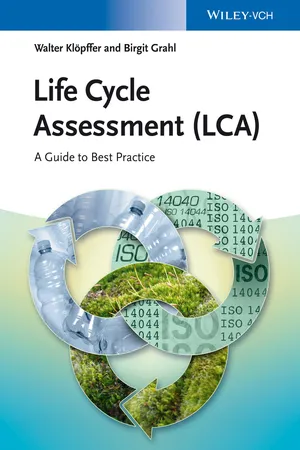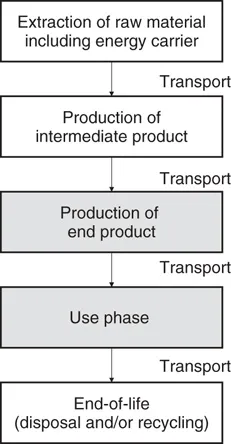
- English
- ePUB (mobile friendly)
- Available on iOS & Android
eBook - ePub
About this book
This first hands-on guide to ISO-compliant Life Cycle Assessment (LCA) makes this powerful tool immediately accessible to both professionals and students. Following a general introduction on the philosophy and purpose of LCA, the reader is taken through all the stages of a complete LCA analysis, with each step exemplified by real-life data from a major LCA project on beverage packaging. Measures as carbon and water footprint, based on the most recent international standards and definitions, are addressed.
Written by two pioneers of LCA, this practical volume is targeted at first-time LCA users but equally makes a much-valued reference for more experienced practitioners.
From the content:
* Goal and Scope Definition
* Life Cycle Inventory Analysis
* Life Cycle Impact Assessment
* Interpretation, Reporting and Critical Review
* From LCA to Sustainability Assessment
and more.
Written by two pioneers of LCA, this practical volume is targeted at first-time LCA users but equally makes a much-valued reference for more experienced practitioners.
From the content:
* Goal and Scope Definition
* Life Cycle Inventory Analysis
* Life Cycle Impact Assessment
* Interpretation, Reporting and Critical Review
* From LCA to Sustainability Assessment
and more.
Frequently asked questions
Yes, you can cancel anytime from the Subscription tab in your account settings on the Perlego website. Your subscription will stay active until the end of your current billing period. Learn how to cancel your subscription.
No, books cannot be downloaded as external files, such as PDFs, for use outside of Perlego. However, you can download books within the Perlego app for offline reading on mobile or tablet. Learn more here.
Perlego offers two plans: Essential and Complete
- Essential is ideal for learners and professionals who enjoy exploring a wide range of subjects. Access the Essential Library with 800,000+ trusted titles and best-sellers across business, personal growth, and the humanities. Includes unlimited reading time and Standard Read Aloud voice.
- Complete: Perfect for advanced learners and researchers needing full, unrestricted access. Unlock 1.4M+ books across hundreds of subjects, including academic and specialized titles. The Complete Plan also includes advanced features like Premium Read Aloud and Research Assistant.
We are an online textbook subscription service, where you can get access to an entire online library for less than the price of a single book per month. With over 1 million books across 1000+ topics, we’ve got you covered! Learn more here.
Look out for the read-aloud symbol on your next book to see if you can listen to it. The read-aloud tool reads text aloud for you, highlighting the text as it is being read. You can pause it, speed it up and slow it down. Learn more here.
Yes! You can use the Perlego app on both iOS or Android devices to read anytime, anywhere — even offline. Perfect for commutes or when you’re on the go.
Please note we cannot support devices running on iOS 13 and Android 7 or earlier. Learn more about using the app.
Please note we cannot support devices running on iOS 13 and Android 7 or earlier. Learn more about using the app.
Yes, you can access Life Cycle Assessment (LCA) by Walter Klöpffer,Birgit Grahl in PDF and/or ePUB format, as well as other popular books in Physical Sciences & Organic Chemistry. We have over one million books available in our catalogue for you to explore.
Information
1
Introduction
To date life cycle assessment (LCA) is a method defined by the international standards ISO 14040 and 14044 to analyse environmental aspects and impacts of product systems. Therefore, the introduction of the methodology in Chapters 2–5 relates to these standards. As a prelude, the scope and development of the methodology are introduced here.
1.1 What Is Life Cycle Assessment (LCA)?
1.1.1 Definition and Limitations
In the introductory part of international standard ISO 140401 serving as a framework, LCA has been defined as follows:
LCA studies the environmental aspects and potential impacts throughout a product's life (i.e. cradle-to-grave) from raw material acquisition through production, use and disposal. The general categories of environmental impacts needing consideration include resource use, human health, and ecological consequences.
A similar definition of LCA was adopted as early as 1993 by the Society of Environmental Toxicology and Chemistry (SETAC)2 in the ‘Code of Practice’.3
Similar definitions can also be found in the basic guidelines of4 DIN-NAGUS as well as in the ‘Nordic Guidelines’5 commissioned by Scandinavian Ministers of the Environment. Those deliberate limitations of LCA to analysis and interpretation of environmental impacts have the consequence that the method is restricted to only quantify6 the ecological aspect of sustainability (see Chapter 6). The exclusion of economical and social factors distinguishes LCA from product line analysis (PLA) (Produktlinienanalyse) and similar methods.7 This separation was made to avoid a method overload, being well aware that a decision, for example, in the development of sustainable products, cannot and must not neglect these factors.8
1.1.2 Life Cycle of a Product
The main idea of a cradle-to-grave analysis, that is, the life cycle of a product, is illustrated in a simplified manner in Figure 1.1. Usually, the starting point for building a product tree is the production of the end product and the use phase. Further diversification of the boxes in Figure 1.1 into singular processes, the so-called unit processes, as well as the inclusion of transports, diverse energy supply, co-products, and so on, turn this simplistic scheme, even with simple products, into very complex ‘product trees’ (diverse raw materials and energy supply, intermediate products, co-products, ancillary material, waste management including diverse disposal types and recycling).

Figure 1.1 Simplified life cycle of a tangible product.
Interconnected unit processes (life cycle or product tree) form a product system. The centre is a product, a process, a service or, in the widest sense, a human activity.9 In an LCA, systems that serve a specific function and therefore have a specified performance are analysed.
Therefore, the quantified performance (avail) of a product system is the intrinsic standard of comparison (reference unit). It is the sole correct basis for the definition of a ‘functional unit’.10
1.1.3 Functional Unit
Besides the cradle-to-grave analysis (thinking in terms of systems, life cycles or production trees), the functional unit is the second basic term in an LCA and is therefore to be explained here.
The function of a beverage packaging, for example, is – besides shielding of the liquid – above all, transportability and storability. The functional unit is most frequently defined as the provision of 1000 l liquid in a way to fulfil the technical aspects of the performance. This function can, for instance, be mapped with different packaging specifications (the following examples are arbitrarily chosen):
- 5000 0.2 l11 pouches
- 2000 0.5 l reusable bottles of glass
- 1000 1 l single-use beverage carton
- 500 2 l PET (polyethylene terephthalate) single-use bottles.
Thus, for a comparison of packaging systems, the life cycle of 5000 pouches, 2000 reusable glass bottles, 1000 cardboards and 500 2 l PET bottles, which are four product systems that roughly fulfil the same function, needs to be analysed and compared.
Slight variations in performance (convenience, e.g. weight, user friendliness, aesthetics, customer behaviour, suitability as advertising medium or other side effects of packaging systems) are not important in this simplistic example. It is, however, important to note that sys...
Table of contents
- Cover
- Title Page
- Related Titles
- Copyright
- Preface
- Chapter 1: Introduction
- Chapter 2: Goal and Scope Definition
- Chapter 3: Life Cycle Inventory Analysis
- Chapter 4: Life Cycle Impact Assessment
- Chapter 5: Life Cycle Interpretation, Reporting and Critical Review
- Chapter 6: From LCA to Sustainability Assessment
- APPENDIX A: Solution of Exercises
- Appendix B: Standard Report Sheet of Electricity Mix Germany (UBA 2000, Materials p. 179ff) Historic example, only for illustrative purposes
- Acronyms/Abbreviations
- Index
- End User License Agreement